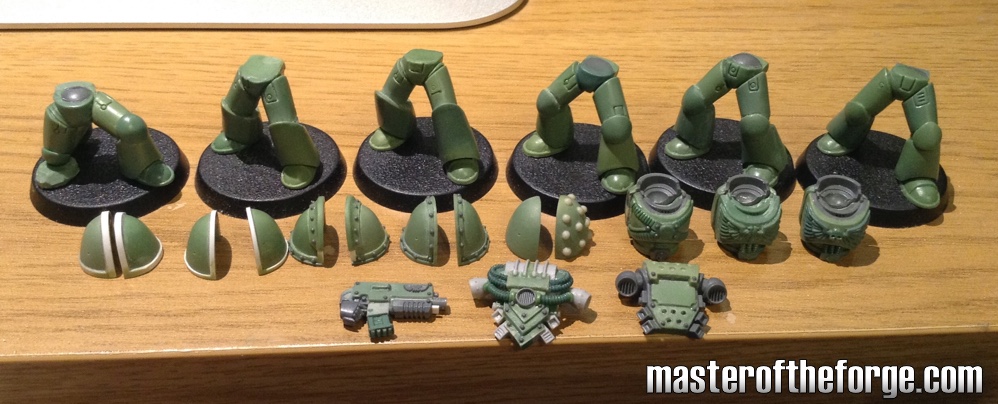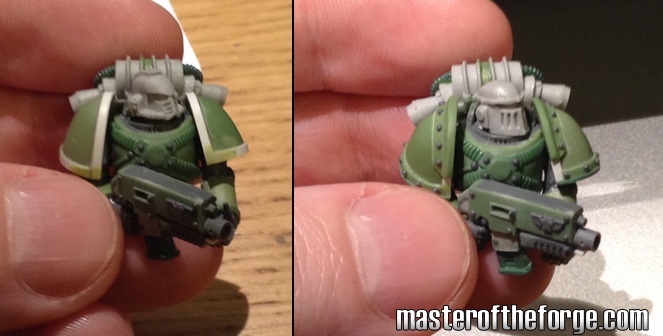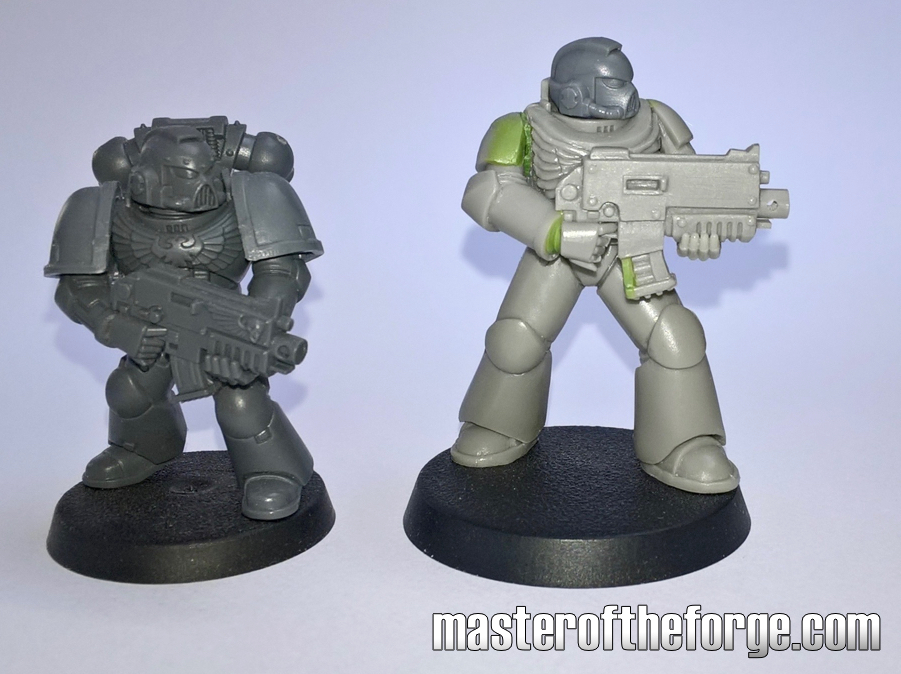The Big Project.
Artscale Space Marines. I coined the term Artscale after jumping on the truescale space marine bandwagon years ago. I felt it was a better fit to describe what I was personally trying to do, as truescale really refers to accurately proportioned figures, whilst I always endeavour to capture the qualities of the artwork I’m using as reference material in my miniatures (which is rarely proportioned accurately, but does look cool).
I’ve been making these things for a long time, but ironically still don’t have an army of my own, and it’s time to address that. I’ve always made these miniatures by converting existing models (typically Terminators) with lots of Greenstuff. This is fine for one offs and small squads but is not very realistic for building whole armies. So obviously casting components is the way forward. As my skills as a caster are hypothetical at best, so I’m collaborating with someone else with the skills and equipment to cast things properly.
I should also mention none of these casts will be available for sale as kits, but I will be open to taking on a limited amount of commission work using these casts to create custom finished pieces.
So starting from the beginning, I knew I wanted the masters for these casts to be as perfect as possible, no rush job. Additionally, I wanted to create a full range of all marks of power armour with variety of pose and all necessary extras. With this in mind I decided I needed to establish baseline measurements on which to work with. I’ve always been a fan of the Space Marine illustrations that the codexes and forgeworld books use to show colour schemes and markings, finding them to be proportioned perfectly to my tastes. So these would be my guideline on which to base sculpts.
To figure this out I created a little line-up in photoshop. Beginning by creating a grid of 1mm squares, I added pics of standard models (a guardsman and a Tactical Marine) that I was able to scale them precisely because I knew they were both on 25mm round bases. As the helms were the only parts I didn’t plan on altering I used the Space Marine helm as the key to determining the actual size of the illustrations. By copying and overlaying it on the illustration, I could adjust the size of the body to fit. Rather perfectly, this equated to an 8 foot tall marine, a little taller than my previous artscales (using terminator legs) and at the absolute limit of how tall a marine should be, but I’m ok with that.

If anyone wants the larger layered Photoshop version of this file (which includes more power armour, terminator and scout scales) for their own use you can find and download it here. Using Photoshop or similar software to test out conversion ideas is very helpful, especially on potentially expensive projects.
Now that I had this lineup, I printed out a twice size version of the image and took precise measurements of all the separate parts (halving the measurement of course) so I knew the exact dimensions of all the components I needed to make. I also printed out the image at actual size that I kept on my desk and used as a direct comparison with the sculpts as I worked on them.
This might seem like a lot of work, but in the long run it’s been invaluable and has allowed me to keep everything very refined and precise.

So onto the sculpts. Some bits were done from scratch and some took standard plastic components which I would strip down to use as a framework. I’m not going to go into too much detail about how I did this, as this is not intended as a tutorial, but I’ll attempt to cover the basics. When sculpting I like to use a 50/50 mix of greenstuff and magic sculp. It retains the qualities of both putties, I like my sculpting putty soft, but once cured it can be carved, scraped, filed, etc. My tools are primarily flat chisel clayshapers (colour shapers) and a scalpel (x-acto blade no.11). I’ll shape the putty as best I can while I can and then once it’s cured I’ll refine it, usually scraping with the edge of a blade and a fine wet&dry paper to get it perfect. If need be, I can add more putty, as the nice thing about this 50/50 mix is that it can be smoothed out really thinly so there is almost no transition line between the fresh putty and the surface it’s been applied to.


I finished the first set of sculpts and sent them off for casting. So far I’ve got back a selection of masters, allowing me to more easily make variants of all the parts. The end goal is to have all necessary components to build all marks of power armour from II to VIII, with at least a couple of variations in stance for each mark. This will make the parts highly suitable for Heresy projects.
Once all the originals are sculpted (I’m well over half way so far), we move onto the production stage, which is out of my hands, but I have supreme confidence in the quality of the final casts. I’ve put together one set of the masters for myself (still waiting on the pads and backpack). Here it is with a standard tac marine for comparison.


So where is this project heading?
The final goal is to build either a full battle company or demi-company of Artscale Space Marines. I expect this to take a good while, but I’m nothing if not patient. I’ve also decided it was also time to up my painting game. My painting skills plateaued about a decade ago, I’m a decent 6 or 7 out 10, and I’ve been fine with that until now, but I think this project deserves a better paint job than I can achieve currently, but I also want to start painting some unconverted miniatures (gasp!). I think the best way to do this will be to start over as if I was a beginner, learning the basics from scratch, rather than just winging it as I normally do. I’m a little slapdash in my painting style and I need it to be a bit more refined.
My chapter of choice for this project is the Ultramarines, specifically the 3rd Company. The main reason for this is because I like the colour scheme, pure and simple. Not a huge fan of the yellow/gold trim of the 2nd company, but the red trim looks great. Secondarily, I like the idea of taking an army we see all the time and painting it as close as possible to the GW studio army, where the only conversion work on the models is their scale. I always say the best conversions are the ones you can’t tell are conversions. The hope is that these sculpts/conversions are so well done that it won’t be immediately apparent that 90% of each model is a re-sculpt. The conversion work will be hidden in plain sight by painting them as close to the norm as possible.
I’ll be basing the force on the one shown in the Scourge of the Xenos: Painting Guide. The main difference will be that instead of everyone being equipped with Mark VII there will be a variety in the marks of armour. There’s a great two page spread in one of the older Space Marine Codexes (5th ed) of the second company. I’ll use that as a guideline on how to mix elements of older marks of armour. Captain Fabian will be modelled and posed based on this piece of art (I love this guys work) as I like my leaders in relaxed commanding poses, over combat poses.
I’m not planning on using any up-scaled vehicles with this project as I’ll be using Drop Pods and I don’t feel that they need any modification to work with scaled up Space Marines. I’m also tempted to add a Dreadnought or two, probably a Leviathan, not sure whether that will be converted. Ideally, I’ll build and fully paint one squad at a time. This will be a long term project but the exciting thing is the potential to use these castings for all manor of other Space Marine and Chaos Space Marine projects.